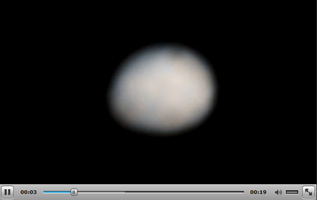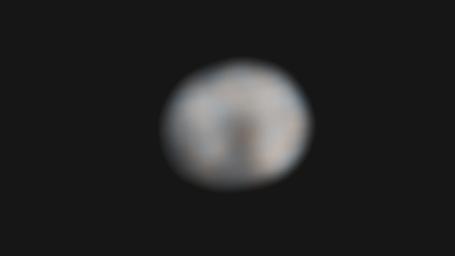
Click on the image for the animationAstronomers combined 146 exposures taken by NASA's Hubble Space Telescope to make this 73-frame movie of the asteroid Vesta's rotation. Vesta completes a rotation every 5.34 hours.
Hubble's Wide Field Camera 3 observed the potato-shaped asteroid in preparation for the visit by NASA's Dawn spacecraft in 2011. The telescope's sharp "eye" can see features as small as about 40 kilometers (25 miles) across in the images used to construct the movie.
The movie shows the difference in brightness and color on the asteroid's surface. These characteristics hint at the large-scale features that the Dawn spacecraft will see when it arrives at the potato-shaped Vesta in July 2011.
The asteroid is somewhat like our moon, with ancient lava beds (the dark patches) and powdery debris, the pulverized remains of impacts (the orange-colored areas). A flattened area on one end of Vesta is a giant impact crater formed by a collision billions of years ago. The crater is 460 kilometers (285 miles) across, close to Vesta's roughly 530-kilometer (330-mile) diameter. The asteroid is about the size of Arizona.
Vesta is one of the largest of a reservoir of about 100,000 asteroids, the leftover material from the formation of our solar system planets 4.6 billion years ago.
Astronomers combined images of Vesta in near-ultraviolet and blue light to make the movie. The Hubble observations were made on Feb. 25 and Feb. 28, 2010.
The Dawn mission to Vesta and Ceres is managed by the Jet Propulsion Laboratory, a division of the California Institute of Technology in Pasadena, for NASA's Science Mission Directorate, Washington. The University of California, Los Angeles, is responsible for overall Dawn mission science. Other scientific partners include Planetary Science Institute, Tucson, Ariz.; Max Planck Institute for Solar System Research, Katlenburg-Lindau, Germany; DLR Institute for Planetary Research, Berlin, Germany; Italian National Institute for Astrophysics, Rome; and the Italian Space Agency, Rome. Orbital Sciences Corporation of Dulles, Va., designed and built the Dawn spacecraft.
To learn more about Dawn and its mission to the asteroid belt, visit http://www.nasa.gov/dawn.

 Planetary Data System
Planetary Data System













